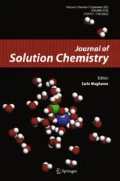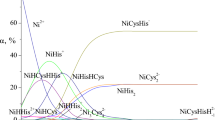Abstract
The binary and mixed-ligand complexes formed between ligands (histidine (His), histamine (Him) and glycine (Gly)) and some transition metals (Cu(II), Ni(II) and Zn(II)) were studied potentiometrically in aqueous solution at (25.0 ± 0.1) ∘C and I = 0.10 M KCl in order to determine the protonation constants of the free ligands and stability constants of binary and ternary complexes. The complexation model for each system has been established by the software program “BEST” from the potentiometric data. The most probable binding mode for each binary species of histidine and for all mixed species was also discussed based upon derived equilibrium constants and stability constants related to the binary species. The ambidentate nature of the histidine ligand, i.e. the ability to coordinate histamine-like, imidazolepropionic acid-like and glycine-like modes was indicated from the results obtained. The stability of ternary complexes was quantitatively compared with their corresponding binary complexes in terms of the parameters, Δlog K, log X and Δ1110. The concentration distributions of various species formed in solution were also evaluated. In terms of the nature of metal ion, the complex stability follows the trend Cu(II) > Ni(II) > Zn(II), which is in agreement with the Irving-Williams’ order of metal ions. Thus, the results obtained were compared and evaluated with those in the literature.
Similar content being viewed by others
References
H. Sigel and A. Sigel, Metal Ions in Biological Systems, Vols. 12 & 13 (Marcel Dekker, New York, 1981).
B. J. Hathaway, in Comprehensive Coordination Chemistry, G. Wilkins, R. D. Gillard and J. A. McCleverty, eds., vol. 5, Chapter 53 (Pergamon, Oxford, 1987).
K. D. Karlin and Z. Tyeklar (eds.), Bioinorganic Chemistry of Copper (Chapman and Hall, New York, 1993).
D. M. Dooley, in Encyclopedia of Inorganic Chemistry, R. B. King, ed., vol. 2, pp. 905–924 (Wiley, New York, 1974).
R. K. Conry and K. D. Karlin, in Encyclopedia of Inorganic Chemistry, R. B. King, ed., vol. 6, pp. 829–846 (Wiley, New York, 1994).
T. J. Spiro (ed.), Metal Ions In Biology Series: Copper Proteins, vol. 3, (Wiley Interscience, New York, 1981).
D. R. Williams, The Metals of Life, Chapter 2–3, pp. 23–54 (The Camelot Press Ltd, London and Southampton, 1971).
H. Sigel, Metal Ions in Biological Systems, vol. 2, Mixed-Ligand Complexes (Marcel Dekker Inc, New York, 1973).
J. J. R. Frausto da Silva and R. J. P. Williams, The Biological Chemistry of the Elements; The Inorganic Chemistry of the Life (Clarendon Press, Oxford, 1991).
R. DeWitt and J. I. Watters, J. Am. Chem. Soc. 76, 3810 (1954).
G. Gran, Acta Chem. Scand. 4, 559 (1950).
F. J. C. Rossotti and H. Rossotti, J. Chem. Edu. 42, 375 (1965).
G. Schwarzenbach, Komplexometrishe Titration, Titration Procedures and Working Instructions; Second Edition, pp. 145–265 (London, Methuen, 1969).
Y. Altun, J. Solution Chem. 33, 479 (2004).
A. E. Martell and R. J. Motekaitis, The Determination and Use of Stability Constants (VCH, Weinheim, 1988).
B. L. Mickel and A. C. Andrews, J. Am. Chem. Soc. 77, 1955 (1955).
A. E. Martell and R. M. Smith, Amino Acids, Critical Stability Constants (New York, 1974).
L. D. Pettit and J. L. M. Swash, J. Chem. Soc., Dalton. Trans. 588 (1976).
M. M. Shoukry, E. M. Khairy, and R. G. Khalil, Trans. Met. Chem. 22, 465 (1997).
S. Sjöberg, Pure Appl. Chem. 69, 1549 (1997).
M. C. M. Fernandes, E. B. M. Paniago, and S. Carvalho, J. Braz. Chem. Soc. 8, 537 (1997).
I. Sovago and A. Gergely, Inorg. Chim Acta 20, 27 (1976).
M. Remelli, C. Munerato, E. Pulidori, J. Chem. Soc., Dalton Trans. 964 (1978).
L. Pettit, Pure Appl. Chem. 56, 247 (1984).
A. Abbaspour, M. A. Kamyabi, Anal. Chim. Acta 512, 257 (2004).
T. Szabó-Plánka, A. Rockenbauer, L. Korecz, and D. Nagy, Polyhedron 19, 1123 (2000).
M. A. Khan, G. Bouet, F. Vierling, J. Meullemeestre, and M. J. Schwing, Trans. Met. Chem. 21, 231 (1996).
H. M. Irving and R. J. P. Williams, J. Chem. Soc. 3192 (1953).
L. Cassella, and M. Gullotti, J. Inorg. Biochem. 18, 19 (1983).
R. J. Sundberg and R. B. Martin, Chem. Rev. 74, 471 (1974).
A. Chakravorty and F. A. Cotton, J. Am. Chem. Soc. 67, 2878 (1963).
M. A. Doran, S. Chaberek, and A. E. Martell, J. Am. Chem. Soc. 2129 (1964).
R. H. Carlson and L. T. Brown, Inorg. Chem. 5, 268 (1966).
H. C. Freeman and R. P. Martin, J. Biol. Chem. 244, 4823 (1969).
J. L. Meyer and J. E. Jr. Bauman, J. Am. Chem. Soc. 92, 4210 (1970).
D. R. Williams, J. Chem. Soc. (A) 1550 (1970).
D. R. Williams, J. Chem. Soc., Dalton Trans. 790 (1972).
R. Nagane, M. Chikira, M. Oumi, H. Shindo, and W. E. Antholine, J. Inorg. Biochem. 78, 243 (2000).
E. Wilson, M. Kasperian, and B. Martin, J. Am. Chem. Soc. 92, 5365 (1970).
H. Sigel and D. B. McCormick, J. Am. Chem. Soc. 93, 2041 (1970).
A. H. Amrallah, N. A. Abdalla, and E. Y. El-Haty, Talanta 46, 491 (1998).
G. Valensin, R. Basosi, W. E. Antholine, and E. Gaggelli, J. Inorg. Biochem. 23, 125 (1983).
R. Leberman and R. B. Rabin, Trans. Faraday Soc. 55, 1660 (1959).
D. D. Perrin and V. S. Scharma, J. Chem. Soc. (A) 446 (1968).
P. J. Morris and R. B. Martin, J. Inorg. Nuel. Chem. 32, 2891 (1970).
T. P. A. Kruck and B. Sarkar, Can. J Chem. 51, 3549 (1973).
G. Arena, R. Call, V. Cucinotta, S. Musumeci, and M. Rizzarelli, J. Chem. Soc., Dalton Trans. 1651 (1984).
G. Brookes and L. D. Pettit, J. Chem. Soc., Dalton Trans. 1224 (1976).
B. A. Goodman, D. B. McPhail, and H. K. J. Powell, J. Chem. Soc., Dalton Trans. 822 (1981).
B. Evertsson and M. J. Gullotti, Inorg. Biochem. 18, 19 (1983).
L. Ruliek and J. Vondrazek, J. Inorg. Bio. 71, 115 (1998).
M. S. Nair, M. Santapa, and P. Natarjan, J. Chem. Soc., Dalton Trans. 1312 (1980).
M. T. El-Haty, A. H. Amrallah, R. A. Mahmoud, and A. A. Ibrahim, Talanta 42, 1711 (1995).
B. Kurzak, K. Bogusz, D. Kroczewska, and J. Jezierska, Polyderon 20, 2627 (2001).
A. Kayali and G. Berthon, J. Chem. Soc., Dalton Trans. 2374 (1980).
V. Manjula, D. Chakraborty, and P. K. Bhattacharya, Indian J. Chem. 29A, 577 (1990).
V. S. Sharma and J. Schubert, J. Chem. Edu. 46, 506 (1969).
Author information
Authors and Affiliations
Corresponding author
Rights and permissions
About this article
Cite this article
Altun, Y., Köseoĝlu, F. Stability of Copper(II), Nickel(II) and Zinc(II) Binary and Ternary Complexes of Histidine, Histamine and Glycine in Aqueous Solution. J Solution Chem 34, 213–231 (2005). https://doi.org/10.1007/s10953-005-2763-7
Received:
Revised:
Issue Date:
DOI: https://doi.org/10.1007/s10953-005-2763-7




